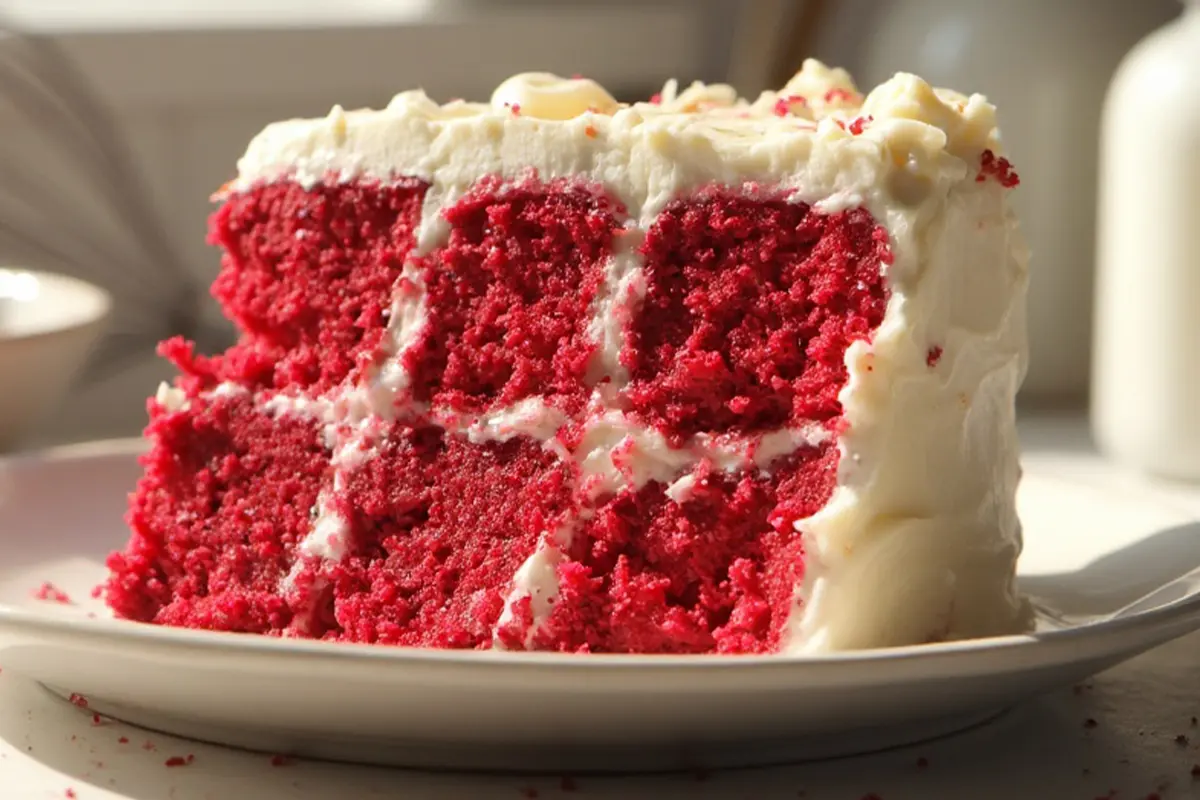Red velvet cake has long been a favorite, not just for its iconic red hue but also for its unique texture and subtle taste. Whether you’re baking a traditional round cake or experimenting with a unique twist like a red velvet Bundt cake, vinegar is one of the most important yet often overlooked ingredients. But why exactly do we put vinegar in this delicious dessert? In this article, we will explore how vinegar contributes to the structure, color, and taste of this beloved cake.
Part 1: The Basics of Red Velvet Cake and Vinegar’s Role
1. What Makes Red Velvet Cake Unique?
Red velvet cake is more than just a chocolate cake with red food coloring. Its distinct texture, tangy flavor, and light crumb are what truly set it apart from other cakes. The secret to achieving this texture and flavor lies in a combination of ingredients, notably vinegar, buttermilk, and cocoa powder.
2. Understanding Vinegar’s Function in Baking
Vinegar, though it may seem an odd addition to a dessert, plays a vital role in baking. When mixed with baking soda, vinegar acts as a leavening agent, helping to create air bubbles and give the cake its light, fluffy texture. Without vinegar, red velvet cake would lack its signature rise and softness.
In fact, one of the reasons you might find vinegar used in many classic recipes is its ability to work alongside other ingredients like buttermilk. Buttermilk, being slightly acidic, also reacts with baking soda in a similar way. Learn more about how vinegar works in baking.
Part 2: The Science Behind Vinegar and Red Velvet Cake
3. Vinegar’s Reaction with Baking Soda
First and foremost, the primary reason for adding vinegar to a red velvet cake recipe is due to its interaction with baking soda. When combined, this chemical reaction creates carbon dioxide, which, in turn, causes the cake to rise. As a result, the combination of vinegar and baking soda ensures that the cake remains light and moist throughout the baking process.
Understanding the Chemistry Behind It
To explain further, here’s what happens:
- Vinegar (acid) + Baking soda (base) = Carbon dioxide (gas)
Consequently, the gas bubbles produced are then trapped in the batter, causing it to rise and create the cake’s delicate structure. Without this reaction, the cake would not achieve the same airy texture and might end up dense and flat. Thus, this reaction is essential for producing the signature texture of a perfect red velvet cake.
By working together, vinegar and baking soda provide the necessary lift that gives the cake its recognizable lightness and soft crumb.
4. Enhancing the Color of Red Velvet Cake
Another reason vinegar is important in red velvet cake is its effect on the cake’s color. Traditionally, the vibrant hue came from the natural reaction between cocoa powder and acidic ingredients such as buttermilk and vinegar. Before food coloring became common, this reaction would result in a deep, reddish-brown shade, giving the cake its distinct appearance.
In modern recipes, vinegar helps enhance the vibrancy of the red food coloring, creating the bold, beautiful red color we associate with the cake today. Find out more about the best vinegars to use in your red velvet cake here.
5. The Role of Buttermilk and Vinegar Together
Buttermilk and vinegar work hand in hand in this recipe. Both are acidic and react with the baking soda, but their unique properties contribute to the cake’s distinct flavor and texture.
- Buttermilk: Adds a tangy flavor and helps tenderize the gluten in the cake, leading to a softer crumb.
- Vinegar: Enhances the leavening process, ensuring that the cake rises beautifully.
By using vinegar and buttermilk together, bakers can achieve the light and airy texture that makes red velvet cake so irresistible.
Part 3: Variations, Substitutions, and Baking Tips
6. Can You Make Red Velvet Cake Without Vinegar?
Yes, it’s possible to make this cake without using vinegar, but it could impact the texture and rise. You can substitute with other acidic ingredients like lemon juice or yogurt, though these alternatives may lead to slight variations in taste and appearance.
Alternative ingredients include:
- Lemon juice: Works similarly to vinegar but may impart a slightly different flavor.
- Yogurt: Acts as both an acidic agent and a moisture-enhancer in the cake batter.
- Sour cream: Adds tang and moisture, creating a rich texture without needing vinegar.
However, omitting vinegar or swapping it out might change the cake’s final texture or color, so these substitutions should be used cautiously.
7. The Best Types of Vinegar for Red Velvet Cake
While white vinegar is commonly used in most red velvet cake recipes, other types of vinegar can also be effective, allowing you to tailor the flavor to your liking.
- White vinegar: The most common and neutral choice.
- Apple cider vinegar: Adds a subtle apple flavor that can complement the cake’s sweetness.
- Red wine vinegar: Works well with the red coloring and adds a depth of flavor to the cake.
Choosing the right vinegar depends on your desired flavor and how adventurous you want to be with your cake recipe.
Part 4: Frequently Asked Questions
8. FAQs
What does vinegar do in red velvet cake? It reacts with baking soda to create bubbles, which help the cake rise and achieve a light, fluffy texture. Additionally, when combined with cocoa and food coloring, vinegar enhances the cake’s vibrant red hue.
Can you substitute vinegar in red velvet cake? Yes, substitutes like lemon juice or yogurt can replace vinegar, but they may alter the flavor and texture of the final product.
Does vinegar affect the flavor of red velvet cake? Vinegar doesn’t add a strong flavor on its own. Instead, it contributes to the cake’s overall tanginess when combined with other acidic ingredients like buttermilk.
Part 5: Conclusion and Final Baking Tips
9. Perfecting Red Velvet Cake with Vinegar
Mastering the use of vinegar in red velvet cake is key to achieving its signature texture and vibrant color. By understanding how this ingredient interacts with the rest of the components, you can consistently create a perfectly light, fluffy, and visually striking cake.
10. Pro Tips for Baking the Perfect Red Velvet Cake
- Use the right vinegar: White vinegar is the classic choice, but feel free to experiment with apple cider or red wine vinegar for a unique twist.
- Balance your acids: Too much vinegar can overpower the flavor, so always measure carefully.
- Don’t skip the buttermilk: It works alongside vinegar to create that tangy, tender texture red velvet cake is known for.
By following these tips, you’ll have a cake that’s not only beautiful but deliciously soft, moist, and flavorful.
Ready to bake? Check out this science-based explanation to get an even deeper understanding of red velvet cake and its ingredients.

